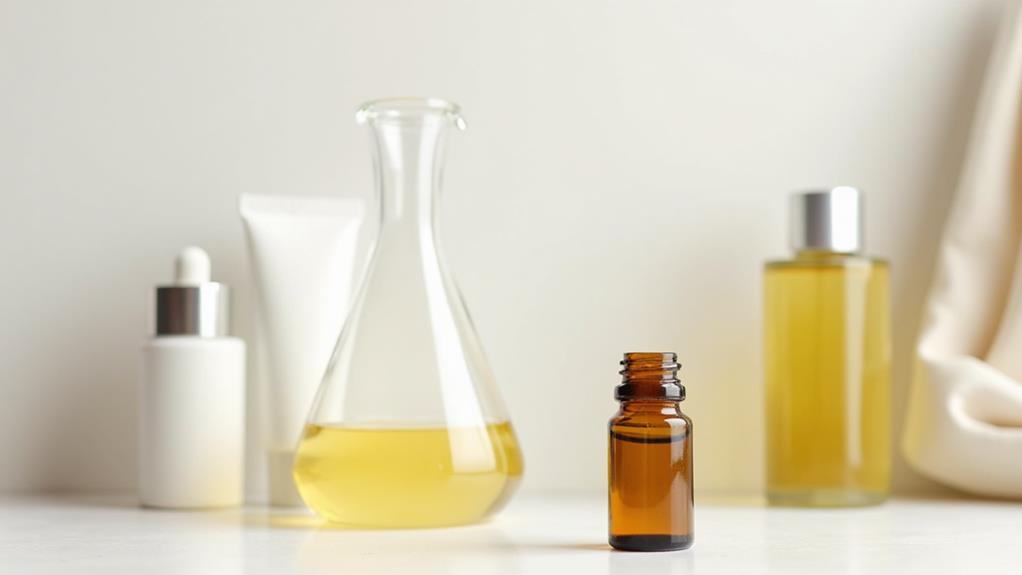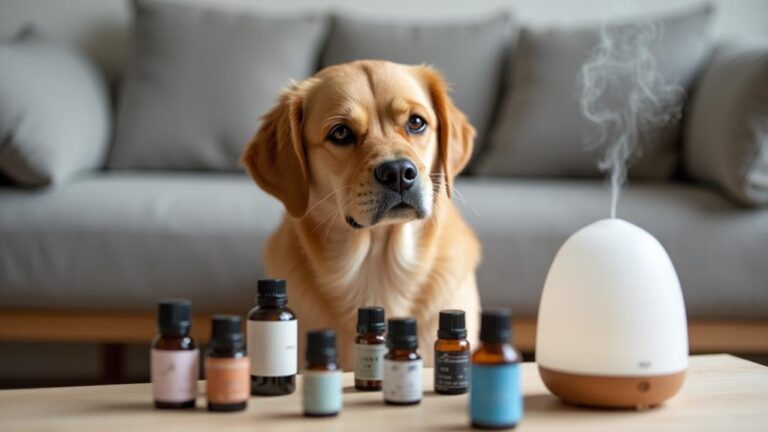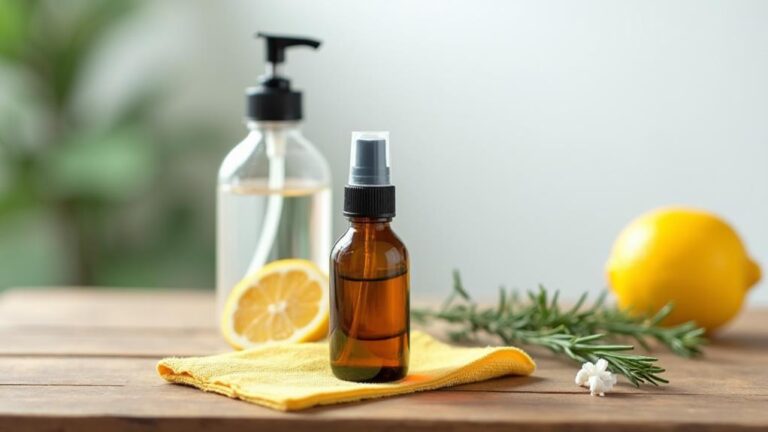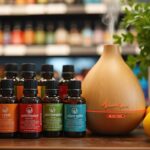When you're creating essential oils for sensitive users, it's vital to balance their therapeutic benefits with potential skin and respiratory sensitivities. You'll want to weigh the unique chemistry of each essential oil and how to neutralize or reduce their scents. This might involve employing specialized techniques like molecular distillation or filtering. However, you may be wondering which essential oils can be used as a starting point for fragrance-free blends. To find out, let's take a closer look at the properties and extraction methods that can help you create effective, low-odor essential oils for sensitive users.
Key Takeaways
- Lavender, Ylang-Ylang, and Geranium oils have low odor thresholds, making them suitable for sensitive users.
- Odor neutralization methods like molecular distillation or filtering can reduce scent in essential oils.
- Fragrance-free essential oils can be created using various methods for users with extreme sensitivities.
- Carrier oils dilute potent essential oils, making them safer for topical application and reducing their potency.
- Patch testing and following international standards are crucial for ensuring the safety and effectiveness of hypoallergenic oils.
Understanding Essential Oil Properties
When you start using essential oils, it's imperative to understand their unique properties to guarantee safe and effective application.
Essential oils are highly concentrated plant extracts, and their properties can vary markedly depending on the plant species, growing conditions, and extraction methods.
Understanding these properties is pivotal to harness their therapeutic benefits while minimizing potential risks.
Essential properties, such as volatility, solubility, and viscosity, influence how an oil interacts with your skin, air, and other substances.
Volatility affects the oil's evaporation rate, while solubility determines its ability to dissolve in water or other liquids.
Viscosity impacts the oil's flow and texture.
Oil characteristics, including pH level, refractive index, and specific gravity, also play a pivotal role in their use and application.
To certify safe and effective use, consider the following factors: the oil's concentration, recommended dilution ratio, and potential interactions with other substances.
Always consult the oil's safety data sheet and follow established guidelines for use.
By understanding essential oil properties and characteristics, you can tap into their therapeutic potential while minimizing risks.
This knowledge is essential for creating effective essential oil blends that cater to sensitive users.
Low Odor Essential Oil Options
Sourcing essential oils with low odor profiles can be a crucial step in creating blends that cater to sensitive users. When selecting low-odor essential oils, you should consider the scent profiles and odor thresholds of individual oils. This will help minimize potential irritation or discomfort for sensitive users.
| Essential Oil | Odor Threshold (ppm) |
|---|---|
| Lavender | 0.2-0.8 |
| Ylang-Ylang | 0.5-1.0 |
| Geranium | 0.8-1.5 |
| Bergamot | 1.0-2.0 |
The table above provides examples of essential oils with relatively low odor thresholds, which can be useful for creating blends with minimal scent profiles. When working with these oils, keep in mind that individual tolerance to odors can vary greatly. You may need to adjust the concentration of each oil to cater to specific user needs. Additionally, consider blending low-odor essential oils with other oils that have complementary properties to create balanced and effective blends. By carefully selecting and combining essential oils, you can create products that are both effective and gentle on sensitive users.
Oil Extraction Methods Matter
When choosing essential oils as a sensitive user, you should consider the extraction method used to obtain the oil.
Cold pressing techniques, which involve mechanically squeezing the oil from the plant material, are a good option as they don't involve heat or harsh chemicals.
You'll also want to look for solvent-free extraction methods, which eliminate the risk of residual chemicals in the oil.
Cold Pressing Techniques
Cold pressing techniques involve extracting essential oils from plants using mechanical pressure, typically through a hydraulic press, and no heat. This method is commonly used for citrus fruits like oranges and lemons, as it helps to preserve the delicate oil composition and aroma.
When you use cold pressing techniques, you'll need to weigh the pressing limits of the plant material, as over-pressing can lead to a decrease in oil quality.
The pressing limit refers to the maximum amount of pressure that can be applied to the plant material without causing damage to the oil glands or releasing unwanted compounds into the oil.
If you exceed the pressing limit, you may end up with an oil that's not only of lower quality but also more likely to cause skin irritation or allergic reactions in sensitive users.
To avoid this, you'll need to carefully monitor the pressing process and adjust the pressure accordingly.
Solvent-Free Extraction Methods
Maintaining the quality of an essential oil requires a careful approach to extraction methods, as different techniques can substantially impact the final product.
In your pursuit of creating essential oils for sensitive users, you'll want to weigh solvent-free extraction methods that minimize risks associated with traditional solvent-based techniques.
Solvent risks, such as contamination and chemical residues, can be detrimental to the health and well-being of your users.
Fortunately, there are several extraction alternatives that don't rely on solvents.
You can explore the following methods:
- *Mechanical expression*: This method involves using a mechanical press to extract oil from plant materials.
- *Enfleurage*: This is a traditional, labor-intensive process that uses fat to absorb the fragrance from delicate plant materials.
- *CO2 extraction*: This method uses high-pressure carbon dioxide to extract essential oils from plant materials.
- *Distillation*: This process involves heating plant materials to release their essential oils, which are then collected and condensed.
The Role of Carrier Oils
One key consideration for sensitive users of essential oils is the role of carrier oils in diluting potent essential oils. Carrier oils are vegetable oils that help dilute essential oils, making them safer for topical application and reducing their potency.
When selecting a carrier oil, you should consider its oil viscosity, as it affects the absorption rate of the essential oil blend. Thicker carrier oils, such as coconut oil, provide a barrier on the skin's surface, while thinner oils, like sweet almond oil, allow for faster absorption.
You can use a single carrier oil or create carrier oil blends to achieve the desired viscosity and skin benefits.
For example, combining jojoba oil with sweet almond oil creates a blend that's easily absorbed and provides moisturizing properties.
When choosing a carrier oil or blend, consider the specific skin type and needs of the user.
Some carrier oils, such as grapeseed oil, are lightweight and non-greasy, making them suitable for acne-prone skin, while others, like avocado oil, are rich and nourishing, making them ideal for dry skin.
Blending for Sensitive Users
When you've selected a suitable carrier oil, it's time to ponder how to blend your essential oils for peak use.
Blending Basics are vital to creating effective sensitive formulations.
You'll want to weigh the specific therapeutic benefits you're aiming for, as well as the potential skin and respiratory sensitivities of your target user.
To create sensitive-friendly blends, follow these guidelines:
- Use mild essential oils with low potential for irritation, such as lavender or chamomile.
- Start with low concentrations (typically 1-2%) and gradually increase as needed.
- Combine complementary oils to achieve a balanced therapeutic effect.
- Record your blend ratios and test them on small groups to refine your formulation.
Fragrance Free Essential Oils
When using essential oils for sensitive skin or allergies, you may require fragrance-free options.
To achieve this, you'll explore odor neutralization methods, such as molecular distillation or filtering, which can substantially reduce the scent of essential oils.
You'll also examine hypoallergenic oil options, including those derived from botanicals known for their gentle, non-irritating properties.
Odor Neutralization Methods
For users with extreme sensitivities, fragrance-free essential oils are often a more viable option.
To achieve this, manufacturers employ various odor neutralization methods. These techniques aim to eliminate or notably reduce the scent of essential oils, making them more tolerable for sensitive users.
Odor masking agents and scent elimination techniques are commonly used to neutralize the smell of essential oils.
Some of these methods include:
- Chemical modification: Altering the molecular structure of the essential oil to reduce its scent.
- Blending with neutral oils: Combining the essential oil with odorless oils to dilute its scent.
- Adsorption: Using materials like activated carbon or zeolites to absorb and neutralize the odor-causing molecules.
- Encapsulation: Enclosing the essential oil in a microscopic capsule that prevents the scent from being released.
When choosing fragrance-free essential oils, you must verify that the products have undergone these odor neutralization methods.
This guarantees that the resulting oil isn't only scent-free but also safe for use on sensitive skin.
Hypoallergenic Oil Options
You've verified the manufacturer's use of odor neutralization methods, now it's time to explore the various hypoallergenic oil options available. For sensitive users, it's vital to choose oils that are less likely to cause allergic reactions. Hypoallergenic essential oils are formulated to minimize the risk of irritation and are often subjected to rigorous allergy testing and skin patching.
| Hypoallergenic Oil Options | Description |
|---|---|
| Lavender-Free Chamomile Oil | A gentle, fragrance-free alternative to traditional chamomile oil |
| Sensitive Skin Geranium Oil | Carefully formulated to reduce the risk of skin irritation |
| Fragrance-Free Frankincense Oil | A hypoallergenic version of the popular frankincense oil |
| Allergy-Tested Bergamot Oil | Subjected to rigorous skin patching to guarantee minimal irritation |
When selecting a hypoallergenic oil, consider your individual skin type and allergies. Always perform a patch test before using a new oil, even if it's labeled as hypoallergenic. This will help you identify any potential allergens and guarantee a safe experience. By choosing the right hypoallergenic oil and following proper usage guidelines, you can enjoy the benefits of essential oils without compromising your skin health.
Creating Odor Neutralizing Oils
Odor neutralizing oils are complex blends that require a deep understanding of essential oil chemistry and a well-planned approach.
When creating these oils, you'll need to weigh the fragrance profiles of various essential oils and how they interact with each other. Your goal is to create a neutral scent that won't irritate sensitive users.
To achieve this, you'll need to balance the top, middle, and base notes of the fragrance.
- Use fixative oils: Oils like orris root, tonka bean, and vanilla can help stabilize the fragrance and prevent it from changing over time.
- Select oils with low volatility: Oils like sandalwood, patchouli, and vetiver have low volatility, which means they won't evaporate quickly and change the fragrance profile.
- Balance the pH level: Some essential oils can be quite acidic or alkaline, which can affect the skin. You'll need to verify the pH level to create a neutral scent.
- Test the blend: Always test the blend on a small group of people to verify it doesn't cause any irritation or allergic reactions.
The Impact of Dilation Rates
When using essential oils, you'll want to ponder how quickly they can dilate your skin's blood vessels, as this can impact their effects on your body.
The rate at which an essential oil dilates blood vessels can vary substantially depending on its composition and concentration.
Dilation Rate Effects
Essential oils' dilation rate, or the speed at which they evaporate, substantially affects their impact on sensitive users.
When you're working with essential oils, it's vital to ponder the dilation dynamics and how they affect oil sensitivity.
A higher dilation rate means the oil will evaporate faster, potentially causing a stronger reaction in sensitive individuals. Conversely, a lower dilation rate may result in a milder effect.
- Higher dilation rates can lead to increased skin irritation and allergic reactions in sensitive users.
- Lower dilation rates may reduce the potency of the oil, potentially minimizing its benefits.
- The ideal dilation rate varies depending on the specific essential oil, its concentration, and the individual user's sensitivity.
- Understanding dilation rate effects is critical to creating essential oils that cater to sensitive users, ensuring their safety and efficacy.
Measuring Dilation Speed
To better understand how dilation rates affect sensitive users, you need to measure the speed at which essential oils evaporate.
This can be achieved by tracking the rate of change in the oil's concentration over time. You'll need to establish a baseline by measuring the initial concentration of the oil and then monitor its decrease as it evaporates. This data will help you calculate the dilation rate and identify any patterns or trends.
When measuring dilation speed, consider using dilation metrics such as evaporation rate, diffusion coefficient, or vapor pressure.
These metrics provide valuable insights into how quickly the essential oils spread and dissipate in the air. Be aware that speed variability can occur due to factors like temperature, humidity, and air circulation, which can impact the accuracy of your measurements.
To ensure accuracy, you must maintain a controlled environment and use precise instruments, such as spectrophotometers or gas chromatographs, to collect data.
Choosing Gentle Essential Oils
At the outset of your journey to incorporate essential oils into your routine, it's crucial you select oils that are gentle on your skin and won't cause adverse reactions.
Your oil preferences and essential tolerance play a significant role in determining which oils are suitable for you.
When choosing gentle essential oils, consider the following factors:
- *Lavander oil*, often considered a calming oil, can still cause skin irritation in some individuals.
- *Chamomile oil* is generally well-tolerated, but its gentle nature may not be suitable for those with low essential tolerance.
- *Ylang-ylang oil* is known for its soothing properties, but it can be too overpowering for sensitive users.
- *Bergamot oil* has a gentle citrus scent, but it can cause photosensitivity in some individuals.
When selecting essential oils, it's imperative to assess your skin's sensitivity and essential tolerance.
Start with small patches and gradually increase the amount to gauge your reaction.
Making Essential Oils Safe
You're taking the right step by choosing gentle essential oils, but that's only half the battle – ensuring safe usage is equally crucial.
To guarantee safety, following oil regulations and guidelines is imperative. Familiarize yourself with the International Organization for Standardization (ISO) and the International Federation of Essential Oil and Aroma Trades (IFEAT) standards for essential oil quality and safety. These organizations provide guidelines for testing, labeling, and packaging essential oils.
When using essential oils, always perform sensitive testing to identify potential skin irritations or allergic reactions.
Start by applying a small amount of oil to a discrete area of skin, such as the inner elbow or behind the ear. Monitor the area for 24-48 hours for any adverse reactions. If you experience redness, itching, or swelling, discontinue use and consult with a healthcare professional.
Additionally, always dilute essential oils with a carrier oil, and follow the recommended concentration ratios to avoid skin irritation. By adhering to these safety protocols, you can minimize the risks associated with essential oil use and enjoy their benefits safely.
Frequently Asked Questions
Can I Make Fragrance-Free Essential Oils at Home?
You can attempt to make fragrance-free essential oils at home, but it's challenging. Home distillation and DIY extraction methods can be used, but removing all fragrance compounds requires advanced equipment and expertise, posing a significant technical hurdle.
How Long Do Odor-Neutralizing Essential Oils Last?
You might be surprised to know that 70% of essential oils degrade within 1-3 years. When considering odor-neutralizing essential oils, shelf life factors and oil degradation rates play a vital role, impacting their 2-5 year shelf life.
Are Carrier Oils Also Fragrance-Free?
When you're working with carrier oils, you'll find that many are naturally fragrance-free. However, blending limitations exist due to oil interactions, which can sometimes alter their neutral scent profile, especially when combined with other ingredients.
Can I Use Odorless Essential Oils on Pets?
When using essential oils on pets, you must consider pet allergies and potential sensitivities. Look for products that have undergone animal testing and consult with a veterinarian to verify the oils are safe for use.
Do Fragrance-Free Essential Oils Have Reduced Benefits?
When considering fragrance-free essential oils, you'll find their therapeutic efficacy remains intact as potency preservation methods are applied during processing, ensuring bioactive compounds remain effective, even without the characteristic scent.
Conclusion
You've navigated the complexities of creating essential oils without smell for sensitive users, and now you're equipped to formulate effective, fragrance-free blends. It's like finding a needle in a haystack – once you understand the intricacies of essential oil chemistry and extraction methods, you can isolate the therapeutic benefits while minimizing potential sensitivities. By applying this knowledge, you can craft gentle, odor-neutralizing oils that are safe for even the most sensitive users.














